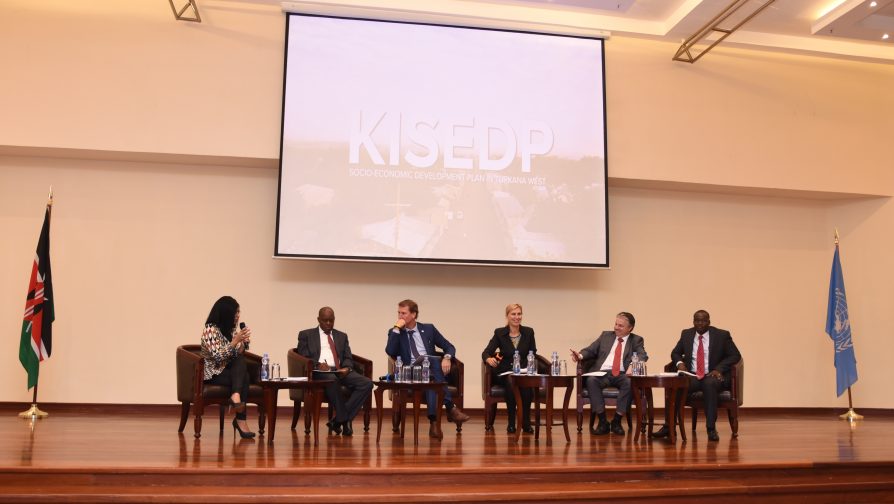“KISEDP has a bottom up approach in addressing refugee and host community issues.”
Group photo at the official launch attended by national and county government officials, the European Union, the World Bank who were partners in the launch through its private sector arm IFC, UNHCR partner organisations and staff. (© UNHCR/Caroline Opile
UNHCR and the Government of Turkana County in northern Kenya, have launched a new development plan. The ‘Kalobeyei Integrated Socio-Economic Development Program’ known as KISEDP hopes to ensure refugees and local communities benefit from national services such as education and healthcare, and increased socio-economic opportunities, all anchored in building the skills and increasing the capacity of refugees and the Kenyans in the local community.
The hope is to increase self-reliance among refugees, and reduce poverty.
There are 186,000 refugees in Turkana County, nearly all on Turkana West living in Kakuma and Kalobeyei. The refugees are predominately from South Sudan, and nationals of 19 other countries including the Democratic Republic of Congo and Burundi. The local Kenyan population that may benefit from the plan is estimated to be around 300,000.
The launch was attended by national and county government officials, the European Union, the World Bank who were partners in the launch through its private sector arm IFC, UNHCR partner organisations, and staff.
The Governor of Turkana County, Josphat Nanok made this statement about the importance of the plan and said, “KISEDP has a bottom up approach in addressing refugee and host community issues. Since the pilot began, conflict between the two communities over resources have reduced. He noted that integration (of refugees) is a critical component of the plan as it accommodated both refugees and host communities.”
Nanok reiterated that expectations among the refugees and host communities to see KISEDP work were high, and said the political will to achieve KISEDP was alive. The Governor said the plan would address needs of areas that host refugees.
It is possible to welcome and assist refugees and for them not to be seen as a burden
UNHCR Representative in Kenya, Raouf Mazou said a change in mindset would be required to make KISEDP work.
“It is possible to welcome and assist refugees and for them not to be seen as a burden. Everything we do for refugees has to be embedded in the vision to develop innovative ways in refugee management in a sustainable manner in collaboration with the County Government of Turkana”. Raouf Mazou, UNHCR Representative

Panellists at the launch of Kalobeyei Integrated Socio-Economic Development Programmme (KISEDP) in Turkana West © UNHCR/Samuel Otieno
The plan highlights the needs and opportunities for state and private investments in sectors such as energy, agriculture, education, and health, and infrastructure. A recent study by International Finance Corporation (IFC) showed that the economy in the area is worth KES 2.7 billion ($26.2 million).
Michel Botzung from IFC said, “We are all about jobs, if refugees can get jobs, then we can solve a lot of problems and enable them fulfill their dreams.”
The plan indicates the need for humanitarian organisation and development bodies, as well as the private sector to work together for the plan to be achieved. Models and approaches to foster inclusion of both refugees within existing government systems, such as which systems, also formed part of the KISEDP. It was informed by the 2016 World Humanitarian Summit, the UNHCR driven Global Compact on Refugees (GCR), and the UN’s Sustainable Development Goals (SDG’s). It aligns with the Kenya Government’s national development strategy, known as Kenya Vision 2030.
Share on Facebook Share on Twitter